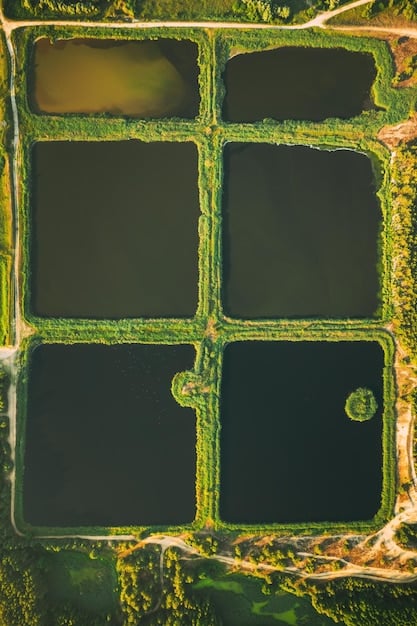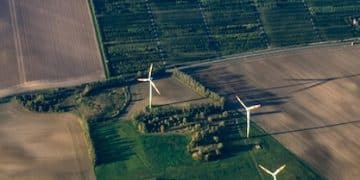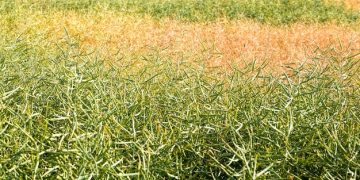Biochar: Unlock Soil Fertility & Carbon Sequestration

Biochar is a charcoal-like substance produced from biomass that can significantly improve soil fertility and sequester carbon, offering a sustainable solution for agricultural practices and environmental benefits.
Discover how to harness the power of biochar to improve soil fertility and contribute to carbon sequestration in agricultural soils. This guide explores the multifaceted benefits and practical applications of biochar, offering a pathway to more sustainable farming practices.
Understanding Biochar: A Sustainable Soil Amendment
Biochar, often dubbed a sustainable soil amendment, is gaining traction for its potential not only to boost agricultural yields but also to play a crucial role in carbon sequestration. Derived from biomass through a process called pyrolysis, it promises a greener approach to farming.
What Exactly is Biochar?
Biochar is a carbon-rich material produced by heating biomass in an oxygen-limited environment. This process, known as pyrolysis, transforms organic matter into a stable form of carbon that can persist in soils for centuries.
The Benefits of Biochar in Agriculture
Adding biochar to agricultural soils can result in enhanced water retention, improved nutrient availability, and increased microbial activity, leading to healthier plants and more productive yields. These are critical advantages in sustainable agriculture.

- Improved Soil Structure: Biochar enhances soil porosity and aeration.
- Enhanced Water Retention: It increases the soil’s ability to hold water, reducing irrigation needs.
- Nutrient Retention: Biochar prevents nutrient leaching, keeping essential elements available to plants.
- Carbon Sequestration: It effectively locks carbon in the soil, mitigating climate change.
In essence, biochar is more than just a soil additive; it’s a comprehensive tool for sustainable agriculture, offering benefits that address both crop productivity and environmental stewardship.
How Biochar Improves Soil Fertility
Soil fertility, the cornerstone of productive agriculture, can be significantly enhanced through the integration of biochar. Its unique properties lead to a cascade of positive effects on soil health.
Enhancing Nutrient Availability with Biochar
Biochar’s porous structure provides a habitat for beneficial microorganisms, which play a crucial role in nutrient cycling. These microbes help to convert organic matter into forms that plants can readily absorb.
Increasing Water Retention in Soil
One of the most significant benefits of biochar is its ability to increase the water-holding capacity of soils. This is especially valuable in regions prone to drought or water scarcity.

- Better Root Development: Improved soil structure allows roots to penetrate deeper and access more nutrients.
- Reduced Fertilizer Needs: Enhanced nutrient retention minimizes the need for synthetic fertilizers.
- Increased Crop Yields: Healthier plants are more productive and resilient to stress.
- Disease Suppression: Biochar can help suppress soil-borne diseases, promoting plant health.
In summary, biochar provides a comprehensive approach to soil fertility management, addressing multiple aspects of soil health simultaneously and fostering sustainable agricultural productivity.
The Role of Biochar in Carbon Sequestration
Beyond its benefits to soil fertility, biochar plays a pivotal role in addressing climate change through carbon sequestration. Its contribution to mitigating greenhouse gas emissions is increasingly recognized.
What is Carbon Sequestration?
Carbon sequestration is the process of capturing and storing atmospheric carbon dioxide, reducing the amount of CO2 in the atmosphere and mitigating the impact of climate change.
How Biochar Sequester Carbon
Biochar effectively sequesters carbon by converting biomass into a stable form of carbon that can persist in soils for hundreds or even thousands of years. This prevents the carbon from being released back into the atmosphere as CO2.
By integrating biochar into agricultural practices, farmers can contribute to climate change mitigation while simultaneously improving soil health and enhancing crop productivity. This dual benefit makes biochar a compelling solution for sustainable agriculture.
Producing Biochar: Methods and Considerations
The production of biochar is a critical step in harnessing its benefits for soil fertility and carbon sequestration. Understanding the methods and considerations involved is essential for sustainable and effective biochar use.
Pyrolysis: The Key Process
Pyrolysis, the thermal decomposition of biomass in the absence of oxygen, is the primary method for producing biochar. This process converts organic materials into biochar, bio-oil, and syngas.
Factors Influencing Biochar Quality
The quality of biochar is influenced by several factors, including the type of biomass used, the pyrolysis temperature, and the residence time. These factors affect the carbon content, surface area, and nutrient composition of the biochar.
By carefully controlling the production process, it is possible to tailor biochar to specific soil types and crop needs, maximizing its benefits for soil fertility and carbon sequestration. Additionally, sustainable sourcing of biomass is essential to ensure the environmental credentials of biochar production.
Applying Biochar to Agricultural Soils: Best Practices
The effective application of biochar to agricultural soils is crucial for realizing its full potential in improving soil fertility and sequestering carbon. Understanding best practices ensures optimal results.
Determining the Right Application Rate
The appropriate application rate of biochar depends on several factors, including the type of soil, the crop being grown, and the properties of the biochar itself. Soil testing can help determine the optimal rate for specific conditions.
Mixing Biochar into the Soil
Properly incorporating biochar into the soil is essential for maximizing its benefits. This can be achieved through various methods, such as tilling, broadcasting, or banding.
- Soil Testing: Conduct soil tests to determine nutrient deficiencies and pH levels.
- Biochar Activation: Consider activating biochar with compost or nutrients before application.
- Application Timing: Apply biochar before planting to allow it to integrate into the soil.
- Monitoring Results: Monitor crop growth and soil health to assess the effectiveness of biochar application.
By following these best practices, farmers can effectively utilize biochar to enhance soil fertility, improve crop yields, and contribute to carbon sequestration in a sustainable manner.
The Economics of Biochar: Costs and Benefits
Assessing the economics of biochar is essential for determining its viability as a sustainable agricultural practice. Evaluating the costs and benefits provides a clear picture of its economic impact.
Initial Investment Costs
The initial investment costs associated with biochar include the cost of the biochar itself, as well as the equipment and labor required for its application. These costs can vary depending on the scale of the operation and the source of the biochar.
Long-Term Economic Benefits
The long-term economic benefits of biochar include increased crop yields, reduced fertilizer costs, and improved water use efficiency. These benefits can offset the initial investment costs over time, making biochar economically attractive.
Furthermore, the potential for carbon credits and other incentives for carbon sequestration can further enhance the economic viability of biochar. By considering both the costs and benefits, farmers can make informed decisions about the economic feasibility of integrating biochar into their agricultural practices.
| Key Aspects | Brief Description |
|---|---|
| 🌱 Soil Fertility | Improves nutrient retention and water-holding capacity in soil. |
| 🌍 Carbon Sequestration | Locks carbon in the ground, reducing atmospheric CO2 levels. |
| 💰 Economic Benefits | Increases crop yields and reduces fertilizer costs long-term. |
Frequently Asked Questions About Biochar
▼
Biochar is a charcoal-like material produced from biomass through pyrolysis, which involves heating organic matter in an oxygen-limited environment. This process creates a stable form of carbon used for soil amendment.
▼
Biochar enhances soil fertility by improving water retention, increasing nutrient availability, and providing a habitat for beneficial microorganisms. These factors contribute to healthier, more productive soil.
▼
Biochar sequesters carbon by converting biomass into a stable form of carbon that remains stored in soils for centuries. This prevents the carbon from being released into the atmosphere as a greenhouse gas.
▼
For optimal results, biochar should be applied based on soil testing and crop requirements. It’s best to mix biochar thoroughly into the soil before planting, and consider activating it with compost or nutrients.
▼
Economically, biochar offers long-term benefits such as increased crop yields, reduced fertilizer costs, and improved water efficiency. Additionally, carbon credits can provide further economic incentives.
Conclusion
Integrating biochar into agricultural soils presents a dual benefit: improved soil fertility and effective carbon sequestration. By understanding and implementing best practices in its production and application, farmers can contribute to more sustainable and productive agricultural systems, while also mitigating climate change.





